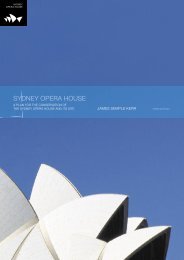nomination by the Government of Australia - Sydney Opera House
nomination by the Government of Australia - Sydney Opera House
nomination by the Government of Australia - Sydney Opera House
You also want an ePaper? Increase the reach of your titles
YUMPU automatically turns print PDFs into web optimized ePapers that Google loves.
3.39 3.40<br />
3.41<br />
Masterpieces <strong>of</strong> <strong>the</strong> 20th century that challenged<br />
conventional norms <strong>of</strong> building expression, siting<br />
and planning<br />
A number <strong>of</strong> signifi cant 20th century buildings have<br />
successfully challenged conventional imagery and<br />
architectural typologies in ways comparable to<br />
<strong>the</strong> <strong>Sydney</strong> <strong>Opera</strong> <strong>House</strong>. These include <strong>the</strong> city<br />
<strong>of</strong> Brasilia (Brazil 1957–1960), <strong>the</strong> Guggenheim<br />
Museum (Spain 1993 –1997), <strong>the</strong> Getty Centre<br />
(United States 1997) and <strong>the</strong> Centre Georges<br />
Pompidou (France 1977).<br />
The new capital city <strong>of</strong> Brasilia was inscribed on <strong>the</strong><br />
World Heritage List in 1987 for <strong>the</strong> achievement <strong>of</strong><br />
Oscar Niemeyer’s architecture and Lucio Costa’s<br />
town planning. Niemeyer respected all schools <strong>of</strong><br />
architecture ‘from <strong>the</strong> chill and elemental structures <strong>of</strong><br />
Mies van der Rohe to <strong>the</strong> imagination and delirium <strong>of</strong><br />
Gaudi’ (Niemeyer 1988: 4)). His own design refl ected<br />
<strong>the</strong> spirit <strong>of</strong> Brazil with ‘beauty prevailing over <strong>the</strong><br />
limitations <strong>of</strong> <strong>the</strong> constructive logic’ (Niemeyer 1988: 5).<br />
Niemeyer’s vast public buildings in Brasilia are dramatic<br />
free-standing architectural statements, sitting lightly<br />
on thin platforms and seeming to fl oat above <strong>the</strong> fl at<br />
ground. The delicate detailing <strong>of</strong> structural elements<br />
and <strong>the</strong> quality <strong>of</strong> execution and fi nish are remarkable<br />
for <strong>the</strong>ir time and place. Niemeyer was awarded<br />
<strong>the</strong> Pritzker Prize in 1988 (Pritzker web page 2005).<br />
Both Niemeyer and Utzon share that ability to fi nd<br />
remarkable beauty and poetry in a structural form.<br />
In <strong>the</strong> search <strong>by</strong> architects in <strong>the</strong> mid 20th century<br />
for an appropriate formal, structural and material<br />
language to describe monumentality and civic value<br />
for 20th century architecture, <strong>the</strong> <strong>Sydney</strong> <strong>Opera</strong> <strong>House</strong><br />
represents a defi ning moment with respect to <strong>the</strong> opera<br />
house or cultural centre (Goad 2005). With <strong>the</strong> demise<br />
<strong>of</strong> <strong>the</strong> classical language <strong>of</strong> western architecture after<br />
World War II as <strong>the</strong> basis for monumental works that<br />
Figure 3.39 Oscar Niemeyer’s National Congress<br />
Chambers, Brasilia, 1957–1960<br />
Figure 3.40 Hans Scharoun’s Berlin Philharmonie,<br />
1956–1963<br />
might express civic values, <strong>the</strong> <strong>Sydney</strong> <strong>Opera</strong> <strong>House</strong><br />
design represents a signifi cant point in <strong>the</strong> search for<br />
alternative means <strong>of</strong> expression that had preoccupied<br />
progressive architects since <strong>the</strong> 1920s.<br />
In terms <strong>of</strong> <strong>the</strong> opera house or cultural centre, Utzon’s<br />
design needs to be seen against a range <strong>of</strong> similar<br />
complexes that were constructed after <strong>the</strong> war in<br />
Europe, Britain and <strong>the</strong> United States. When compared<br />
with <strong>the</strong> moderate Modernism <strong>of</strong> Robert Mat<strong>the</strong>w and<br />
Leslie Martin’s Royal Festival Hall in London (1949–<br />
1951), <strong>the</strong> free expression <strong>of</strong> Hans Scharoun’s Berlin<br />
Philharmonie (1956–1963) and Avar Aalto’s Finlandia<br />
Hall in Helsinki (1962, 1967–1972), <strong>the</strong> <strong>Sydney</strong> <strong>Opera</strong><br />
<strong>House</strong> breaks new ground in terms <strong>of</strong> complex sources<br />
<strong>of</strong> architectural representation (see Parts 2.A and<br />
3.A), innovation in structure and technology and an<br />
empa<strong>the</strong>tic relationship between a large public building<br />
and its dramatic natural setting.<br />
The success <strong>of</strong> <strong>the</strong> <strong>Sydney</strong> <strong>Opera</strong> <strong>House</strong> in creating<br />
a cultural centre as a monument or signature building<br />
has been recognised and emulated in a number <strong>of</strong> late<br />
20th century cultural buildings. These include Frank O<br />
Gehry’s Guggenheim Museum in Bilbao (Spain 1993–<br />
1997) and Richard Meier and Partners’ Getty Centre<br />
in Los Angeles (United States 1997). The Guggenheim<br />
Museum (Bilbao), perhaps <strong>the</strong> best known example <strong>of</strong><br />
<strong>the</strong> use <strong>of</strong> a ‘signature building’ as a deliberate urban<br />
design strategy, was strongly modelled on <strong>the</strong> <strong>Sydney</strong><br />
<strong>Opera</strong> <strong>House</strong>. Gehry was asked in <strong>the</strong> brief from <strong>the</strong><br />
Guggenheim Foundation for ‘an equivalent to <strong>the</strong><br />
<strong>Sydney</strong> <strong>Opera</strong> <strong>House</strong> to transform a fading industrial<br />
city through <strong>the</strong> marriage <strong>of</strong> Basque cultural aspiration’<br />
(Thiele-Siling 1998: 182). The city got ‘one <strong>of</strong> <strong>the</strong> most<br />
talked about buildings in years’ (Guggenheim-Bilbao<br />
web site 2000).<br />
Figure 3.41 Frank O Gehry’s Guggenheim Museum,<br />
Bilbao, 1993 –1997<br />
49

















